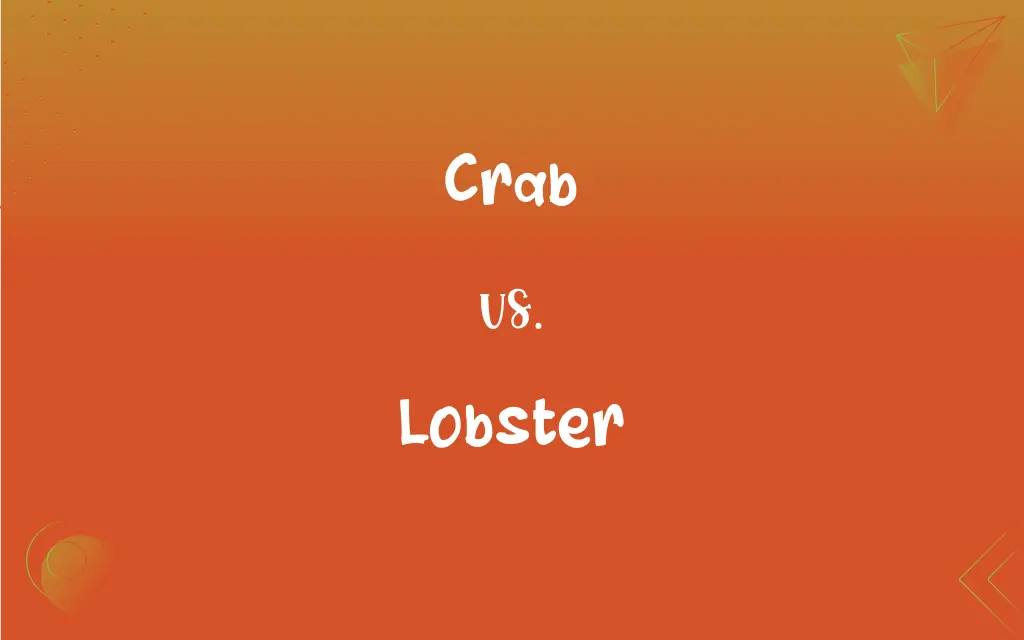Crab vs. Lobster: What's the Difference?
Edited by Janet White || By Harlon Moss || Updated on October 19, 2023
A crab is a decapod with a short, broad body and pincers, while a lobster has a long body, large claws, and a long tail.

Key Differences
A crab possesses a broad, flat body with a hard carapace, allowing it to squeeze into tight spaces, typically found in seafloor crevices. Conversely, a lobster showcases a cylindrical, elongated body with a pronounced tail, enabling it to swiftly dart backward in the water when threatened.
Both crab and lobster sport claws, but they serve different purposes. Crab claws are generally symmetrical and are used for defense and feeding. The lobster, on the other hand, often has one oversized claw for crushing and another slender one for cutting.
Crabs inhabit various environments, from freshwater to marine, and they often dwell in burrows or hide among seaweeds. Lobsters, especially the common American and European varieties, are mainly marine creatures and are usually found on rocky, sandy, or muddy bottoms.
Crabs come in varying sizes, from the tiny pea crab to the giant Japanese spider crab. Lobsters, particularly the American variety, can grow quite large, with some specimens weighing over 40 pounds.
Both crab and lobster play significant roles in global seafood markets. Crabs are harvested worldwide and are key components in numerous dishes. Lobster, especially from the North Atlantic, is regarded as a luxury item and is highly prized for its tender meat.
ADVERTISEMENT
Comparison Chart
Body Structure
Broad, flat body with hard carapace
Elongated body with pronounced tail
Primary Habitat
Marine, freshwater; burrows/seaweeds
Mainly marine; rocky, sandy, or muddy bottoms
Size Range
From tiny to very large
Medium to large
Economic Value
High, used in various dishes
High, considered luxury; tender meat
Claw Functionality
Defensive and for feeding
One for crushing, one for cutting
ADVERTISEMENT
Crab and Lobster Definitions
Crab
A marine crustacean with a broad carapace, short tail, and pincers.
She found a beautiful shell, only to discover it was the home of a small crab.
Lobster
A creature that can regenerate lost limbs over time.
It's amazing how a lobster can regrow a lost claw.
Crab
A creature known for its sideway walking motion.
It's fascinating to watch a crab navigate the beach, moving side to side.
Lobster
A marine crustacean with a long body, large claws, and a distinct tail.
He ordered the lobster bisque as a starter during our fancy dinner.
Crab
An aquatic creature often used as a culinary delicacy in various cultures.
For dinner, we enjoyed a flavorful crab curry.
Lobster
An organism that turns red when cooked, despite its usual dark blue or greenish hue.
She was surprised to learn that the vibrant red lobster on her plate was once a deep blue color.
Crab
A symbol of the zodiac sign Cancer.
As a Cancer, she felt a unique connection to the crab.
Lobster
A sought-after seafood item known for its rich and tender meat.
The restaurant's special tonight is grilled lobster with garlic butter.
Crab
An individual who complains or grumbles frequently.
Don't be such a crab; it's just a small inconvenience!
Lobster
A term sometimes used to describe someone's significant other.
You're my lobster, he said, referencing a popular TV show.
Crab
Any of various chiefly marine decapod crustaceans of the infraorder Brachyura, having a hard carapace that covers a broad flattened cephalothorax with a small abdomen tucked beneath it, and an anterior pair of legs that are large and pincerlike.
Lobster
Any of several edible marine decapod crustaceans of the family Nephropidae, especially of the genus Homarus, having stalked eyes, long antennae, a pair of large pincers, and a cylindrical body.
Crab
Any of various similar decapod crustaceans, such as a hermit crab or a king crab.
Lobster
Any of several similar crustaceans, such as a spiny lobster.
FAQs
Is the crab known for walking sideways?
Yes, crabs are recognized for their sideway walking motion.
What color does a lobster turn when cooked?
A lobster turns red when cooked.
Do both crab and lobster play roles in culinary traditions around the world?
Absolutely, both crab and lobster are key ingredients in various global culinary dishes.
Is lobster considered a luxury dish?
Yes, lobster is often viewed as a luxury seafood item.
Is the zodiac sign Cancer represented by a crab?
Yes, Cancer is symbolized by a crab in the zodiac.
Are crab and lobster commercially significant?
Yes, both crab and lobster have significant commercial value in the seafood market.
Which has a broader body structure, crab or lobster?
Crab has a broader and flatter body compared to lobster.
Is lobster meat found primarily in the tail?
Yes, the majority of the lobster's edible meat is found in its tail, but the claws also contain meat.
Do crabs live in both saltwater and freshwater?
Yes, crabs can be found in both saltwater and freshwater environments.
Which has a more pronounced tail, crab or lobster?
Lobster has a more pronounced tail compared to crab.
Which is larger, crab or lobster?
Generally, lobsters tend to be larger, but there are exceptions like the giant Japanese spider crab.
What are the primary habitats of lobster?
Lobsters typically dwell in rocky, sandy, or muddy bottoms in marine environments.
Are there vegetarian dishes named after the crab?
Yes, dishes like "crab cakes" can have vegetarian versions using imitation crab or other substitutes.
Which is considered more expensive in restaurants, crab or lobster?
Typically, lobster is considered more expensive, but it can vary based on the type and location.
Are there various species of both crab and lobster?
Yes, there are numerous species of both crab and lobster worldwide.
Do crabs often burrow or hide?
Yes, crabs often create burrows or hide among seaweeds and rocks.
Do both crab and lobster belong to the crustacean family?
Yes, both crab and lobster are crustaceans.
Do lobsters regenerate their limbs?
Yes, lobsters can regenerate lost limbs over time.
Do both crab and lobster have claws?
Yes, both crab and lobster have claws, but they serve different functions.
Are crabs and lobsters part of the decapod group?
Yes, both crabs and lobsters are decapods, meaning they have ten legs.
About Author
Written by
Harlon MossHarlon is a seasoned quality moderator and accomplished content writer for Difference Wiki. An alumnus of the prestigious University of California, he earned his degree in Computer Science. Leveraging his academic background, Harlon brings a meticulous and informed perspective to his work, ensuring content accuracy and excellence.
Edited by
Janet WhiteJanet White has been an esteemed writer and blogger for Difference Wiki. Holding a Master's degree in Science and Medical Journalism from the prestigious Boston University, she has consistently demonstrated her expertise and passion for her field. When she's not immersed in her work, Janet relishes her time exercising, delving into a good book, and cherishing moments with friends and family.































































